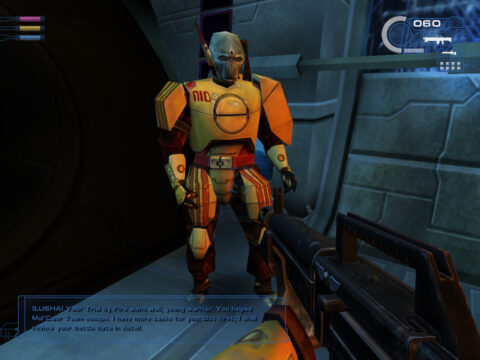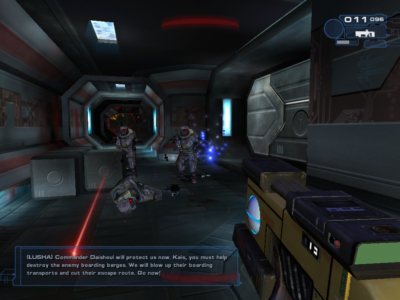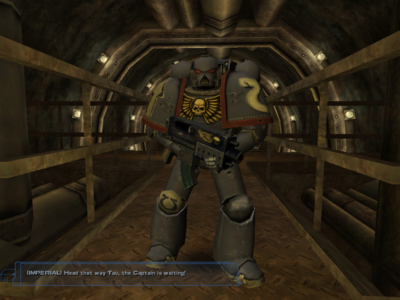
Warhammer 40,000: Fire Warrior
Written by: Stoo
Date posted: January 23, 2016
- Genre: Action
- Developed by: Kuju Entertainment
- Published by: THQ
- Year released: 2003
- Our score: 7 for 40k nerds. Probably a point less for everyone else.
The tabletop wargame Warhammer 40k is known for two things, one being the exquistely detailed and eye-wateringly expensive miniatures. The other would be its utterly bleak and dystopian scifi-fantasy setting. In the far future, the imperium of mankind is locked in a state of constant total war for its very survival, across thousands of battlefields across the galaxy, against a multitude of threats. I count myself as a fan of the game, although one of a particularly lazy and useless type. By which I mean I bought a bunch of orks, but never painted them or found anyone to play. Actually these days I mostly just read the Horus Heresy novels.
Or, play computer games, of course. Over the course of the 1990s, 40k inspired several titles. These generally stuck close to their roots in that, whilst not directly copying the tabletop rules, most such as Chaos Gate were turn-based strategy. Space Hulk had first person sections but it was still a slow, tactical affair with a lot of your time spent looking at map screens. So it was a good decade or so before someone decided to use the setting for something we’d consider an all-out action game, a shooter in the lineage of Doom, Unreal and Half Life.
Now if someone had told me, before I’d heard of this game, that a 40k shooter was being made, I’d have assumed it casts you as a Space Marine. The towering, armoured super-soldiers are after all the most famous aspectof Games Workshop’s entire business, and have indeed been central stars of a few videogames. However you’re not a Marine here, or any sort of human. The title Fire Warrior refers to a soldier of the Tau, an alien race. In fact, humans are the bad guys in the first few levels.
It might seem a novel inversion of usual scifi standards but it’s actually quite fitting, since the Tau are arguably the most positive force at work in the 40k galaxy. The Human Imperium is slowly crumbling, under onslaught from traitors, orks, killer robots and gods that eat hope. It’s also brutal, totalitarian and theocratic. The Tau on the other hand are an optimistic and forward-looking bunch, and reasonably benevolent. By which I mean, if their expanding border reaches your world, they’ll give you a chance to join them before they bomb you back to the stone age.
So it made sense to let the little blue guys have their turn in the spotlight. As a loyal Fire Warrior, the game begins with you being sent on a mission into imperial territory to retrieve a Tau leader captured after a surprise attack. A greater threat arises later, when human traitors summon the demon-tainted forces of Chaos. Incidentally, at least two other major 40k games that decade would use that same plot twist with Chaos – “forget whatever guys you were fighting for half the game, here’s the real threat!”.
The game certainly gets off to an exciting start – you’re a Tau soldier aboard an Aliens-style dropship, and upon landing you’re thrown right into a pitched battle. Some Tau troops are taking cover behind concrete barricades, others snap off shots along trenches. A blaze of red flashes indicate the imperial troops returning fire. There are explosions and shouting in the background. You join in with friendly soldiers, running from one position to the next trying to shut down an Imperial bunker. For a while, it sustains the illusion that there’s an entire battle going on, and you’re not really just running around a bunch of corridors (trenches) with allies who will die when the scripting tells them to.
After that initial beachhead, we progress into a fairly basic, straightforward shooter based on proven ideas of the time. You fight through a lot of linear maps. You’re given simple objectives like planting a bomb or hitting a switch somewhere to over an artillery gun. Scripted sequences such as the arrival of reinforcements help move events along in between the running and gunning. There’s not much innovation here. There are a few elements lifted from Halo that might have been novel to a primarily PC gamer (like yours truly), since the PC didn’t get a port of Bungie’s classic until the same time as FW. For example, you have a defensive shield that recharges after you stop taking damage.
The game does have some further highlights, particularly around midway through when you encounter the mighty Space Marines. They’re huge, imposing, and small arms bounce off their armour as if you’re throwing Doritos at them. Their weapon, the boltgun, is basically a miniature rocket launcher and incidentally, FW is one of the few 40k games to get this right. (Other games tend to depicit it as a machinegun). So facing them is rather more intense than the basic soldiers. For 40k nerds, it was an experience we’d been awaiting for years. Much as we might want to play as marines, it’s a thrill to go into battle against the Emperor’s avenging angels. A boltgun duel involves a lot of diving in and out of cover, and also hoping there aren’t two of them shooting back at you.
Staying on the the topic of weapons a moment, some are sadly weedy. The Tau pulse rifle should do more than spit out wimpy blue flashes; I suppose it’s constrained by being the first gun you get. Others are again true to the tabletop game though: the plasma gun is incandescent firey death, but ammo is rare and precious. The melta gun is basically a heat-ray. The railgun lacks flash and bang, leading to initial disappointment but then you realize A marines are falling over in two hits and B it has a sniper scope and you think, this is actually pretty cool.
Unfortunately another feature plundered from halo is a two-gun limit. Which I guess forces you to make decisions, based on what sort of enemy you anticipate facing. Problem is, your primary Tau-issue gun is fixed at the start of the level. If you’ve found something better, or ammo is low then tough luck I guess, you can only change the second gun. Which led me a few times to dragging a plasma gun around, dropping it for a basic assault rifle to mow down regular enemies, then going back for the plasma (and hoping a door hadn’t locked between me and the gun).
Some of the maps you right through are a bit dull; the first few after the opening are a blur of grimy grey concrete and I can see some gamers losing heart around here. Some better ones again arise halfway through,based around a boarding action between two warships. The Tau ship is very star trek, clean and beige. Then you cross over to the imperial Cruiser, and see just how different their approach to technology is. The ship is like a flying combination of gothic cathedral and industrial works. You fight across battlements, under stained glass windows and over giant turbines. I think at one point I saw coal fired boilers in there. It’s that utterly mad mix of themes that make the game feel properly authentic. Later maps also give you some moderately large (if still linear) outdoor maps with grand imperial buildings, which makes a change if if you’ve had enough.
As awesome as marines are, a good portion of the game is fighting either them or basic grunts. Later on when chaos shows up, well, their standard soldier is also a marine, but with more spikes and evil. They do add a little of variety of their own – the fast moving, screechy raptors and the powerful demon princes. Also some of the weird corruption to the environments around them is vaguely Doom like, which is appropriate as they’re basically the forces of 40k hell.
As you might expect there’s not much of a story to this game, just a series of events as one voiceless Tau soldier guns his way through enemies of the empire. However, it does boast a surprising wealth of british voice acting talent in some of the major roles. That’s Tom Baker’s mellifluous baritone you hear reading the introduction. BRIAN BLESSED turns up as an Imperial admiral, and Sean Pertwee (Alfred in that Gotham show) lends his raspy tone to a Space Marine commander. The non-famously-voiced Tau meanwhile all sound vaguely east-asian so I guess it’s fortunate they’re not the bad guys.
Fire Warrior averages out as a fairly unexceptional shooter of the early 2000s. It’s all quite competently put together, with no grievous errors. There are some memorable fights, boltgun duels with the Adeptus Astartes across the gun decks of a cruiser. Also that opening that is kind of like Medal of honor in Spaaace. However there are also a lot of repetitive shootouts in corridors and switch flipping missions, not to mention sludgy grey walls. There isn’t a lot new brought to the standard shooter formulas. If you don’t care about 40k, I’m guessing FW doesn’t particularly stand out from its peers of the time. (also for modern gamers, it’s a pain in the ass to run it. See below).
If you happen to be a 40k fan then there’s added appeal, of course. It does feel quite authentic. It was the first game to show us the 40k universe up close and personal, and the first to let us experience the thrill of panicking under bolter fire. Still, for all the welcome elements of the 40k universe we encounter, I found myself wishing for more. We could have had a level fighting a tide of rampaging orks, for a change of pace. Or maybe a chance to pilot one of those mini-mecha armour suits, with jumpjets and stacks of guns, for which Tau are famous for in the tabletop game.
Since then Relic have brought us the excellent Dawn of War series of realtime strategy, and also the 2011 third person action title Space Marine, and both items are pretty great. Still Fire Warrior remains our only option for first-person shooting in the 40k universe. So it’s unique in that small regard, at least. If you’re keen to look down the sights of a boltgun, this is it, and it’s not too bad at least.




 Posts
Posts